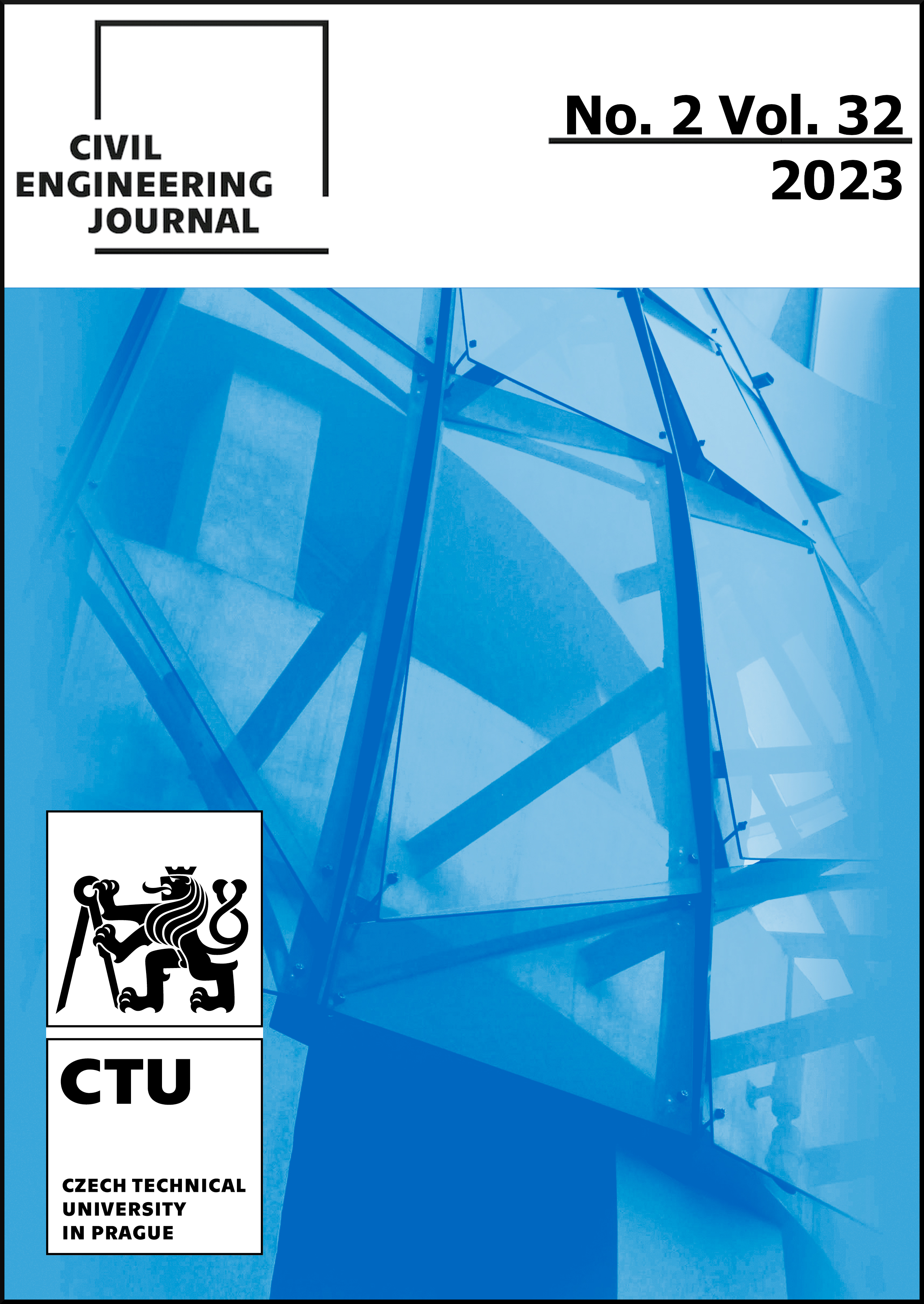Study on the settlement law of tunnel in diatomite stratum based on Strain Softening model
DOI:
https://doi.org/10.14311/CEJ.2023.02.0017Keywords:
Diatomite, strain-softening model, tunnelling, settlement, on-site monitoringAbstract
Nowadays, there is no precedent for building a high-speed railway in diatomite area. Due to the complex structure and poor mechanical properties of diatomite as well as the lack of relevant engineering experience, more attention has been paid to the proper constitutive model of the tunnel in diatomite layer using the numerical calculation method, while the traditional Elastoplastic calculation model is the most used yet. Therefore, relying on the Feifengshan tunnel, through FLAC3D software as well as the on-site monitoring, the analysis of the settlement law about tunnelling in diatomite stratum is carried out based on different constitutive models. The research results show that diatomite has obvious strain-softening characteristics. The calculated surface settlement and vault settlement based on the Strain Softening model was greater than that based on the Mohr Coulomb model. When compared with the on-site monitoring data, it was found that the Strain Softening model would more accurately show the settlement law of the tunnel in diatomite and has better applicability in the diatomite area. The above-mentioned research results may provide some references for the construction and design of tunnels in similar strata in the future.
Downloads
References
Yin, J.H. and Graham, J., 1999. Elastic viscoplastic modeling of the time-dependent stress-strain behavior of soils. Canadian Geotechnical Journal, Vol. 36, 75-105. https://doi.org/10.1051/jp4:2005129032
Liao, H.J., Su, L.J., Yin, J.H., 2004. 3-D elastic viscoplastic modeling analysis of a diatomaceous soft rock. Rock and Soil Mechanics, Vol. 25, 337-341. https://doi.org/10.16285/j.rsm.2004.03.001
Zhang, Y.S., Guo, C.B., Qu, Y.X., et al, 2012. Discovery of swelling diatomite at Tengchong, Yunnan Province and its implication in engineering geology. Journal of Engineering Geology, Vol. 20, 266-275.
Xiang, Q.M, Gao, Y.Q, Su, J.X., et al, 2022. Strata subsidence characteristics of shield tunneling in coastal soft soil area. Stavební obzor-Civil Engineering Journal, 31(3), 444-455. https://doi.org/10.14311/CEJ.2022.03.0033
Luo, J.W., Zhang, D.L., Fang, Q., et al, 2021. Mechanical responses of surrounding rock mass and tunnel linings in large-span triple-arch tunnel. Tunnelling and Underground Space Technology, Vol. 113, 103971. https://doi.org/10.1016/j.tust.2021.103971
Nguyen, T.T., Do, N.A., Karasev, M.A., et al, 2021. Influence of tunnel shape on tunnel lining behaviour. Proceedings of the Institution of Civil Engineers-Geotechnical Engineering, Vol. 174, 355-371. https://doi.org/10.1680/jgeen.20.00057
Qi, W.Q., Yang, Z.Y., Jiang, Y.S., et al, 2021. Structural deformation of existing horseshoe-shaped tunnels by shield overcrossing. KSCE Journal of Civil Engineering, Vol. 25, 735-749. https://doi.org/10.1007/s12205-020-0599-8
Zheng, Y., Wu, K., Jiang, Y.J., et al, 2023. Optimization and design of pre-reinforcement for a subsea tunnel crossing a fault fracture zone. Marine Georesources and Geotechnology, Vol. 41, 36-53. https://doi.org/10.1080/1064119X.2021.2009602
Pan, H.S., Tong, L.Y., Wang, Z.S., et al, 2022. Effects of soil–cement mixing wall construction on adjacent shield tunnel linings in soft soil. Arabian Journal for Science and Engineering, Vol. 47, 13095-13109. https://doi.org/10.1007/s13369-022-06705-9
Nam, S.W. and Bobet, A., 2007. Radial deformations induced by groundwater flow on deep circular tunnels. Rock mechanics and rock engineering, Vol. 40, 23-39. https://doi.org/10.1007/s00603-006-0097-4
Wang, H.D. and He, S.T., 2022. Stability analysis of surrounding rock of shallow-buried subway tunnel with small spacing under different working conditions. Geotechnical and Geological Engineering, Vol. 40, 5065-5079. https://doi.org/10.1007/s10706-022-02200-y
Huang, X., Jia, S.D., Yao, C.F., et al., 2022. Settlement analysis of dense buildings under-passed by shield tunnel considering stratum strain softening. Railway Engineering, Vol. 62, 111-116.
Gao, W.S., Wang, L.C., Zhang, H.J., et al., 2021. Analysis of the contribution of face support and primary support to the surface settlement control of shallow tunnel. Journal of Railway Science and Engineering, Vol. 18, 720-727. https://doi.org/10.19713/j.cnki.43-1423/u.t20210097
Zhao, Y., Li, X.H., Lu, Y.Y., et al., 2008. Orthogonal design of mechanical parameters in a strain softening model for deeply-buried tunnels. Journal of Chongqing University, 716-719.
Lu, Y.L., Wang, L.G., Yang, F., et al., 2010. Post-peak strain softening mechanical properties of weak rock. Chinese Journal of Rock Mechanics and Engineering, Vol. 29, 640-648.
Sun, C., Zhang, X.D., Liu, J.H., 2013. Application of strain softening model to tunnels based on Hoek-Brown strength criterion. Rock and Soil Mechanics, Vol. 34, 2954-2960. https://doi.org/10.16285/j.rsm.2013.10.029
Sun, C., 2013. The research on the strain-softening behavior of the deep joints rock and the interaction between the surrounding rock and the supporting structure. PhD thesis, Liaoning Technical University, Fuxin.
Su, Y.H., and Zou, Y.H., 2020. Stability analysis of support structure based on HOEK-BROWN strain-softening model. Journal of Central South University, Vol. 51, 453-463. https://doi.org/10.11817/j.issn.1672-7207.2020.02.019
Wang, H.B., 2014. Application of strain softening model in numerical simulation of shallow-buried soil tunnel. Master thesis, Huazhong University of Science and Technology, Wuhan.
Alonso, E., Alejano, L.R., Varas, F., et al., 2003. Ground response curves for rock masses exhibiting strain-softening behaviour. International Journal for Numerical and Analytical Methods in Geomechanics, Vol. 27, 1153-1185. https://doi.org/10.1002/nag.315
Downloads
Published
Issue
Section
License
Copyright (c) 2023 Stavební obzor - Civil Engineering Journal

This work is licensed under a Creative Commons Attribution-NonCommercial 4.0 International License.
Authors who publish with this journal agree to the following terms:
- Authors retain copyright and grant the journal right of first publication with the work simultaneously licensed under a Creative Commons Attribution License that allows others to share the work with an acknowledgement of the work's authorship and initial publication in this journal.
- Authors are able to enter into separate, additional contractual arrangements for the non-exclusive distribution of the journal's published version of the work (e.g., post it to an institutional repository or publish it in a book), with an acknowledgement of its initial publication in this journal.
- Authors are permitted and encouraged to post their work online (e.g., in institutional repositories or on their website) prior to and during the submission process, as it can lead to productive exchanges, as well as earlier and greater citation of published work (See The Effect of Open Access).
How to Cite
Accepted 2023-06-24
Published 2023-07-31










